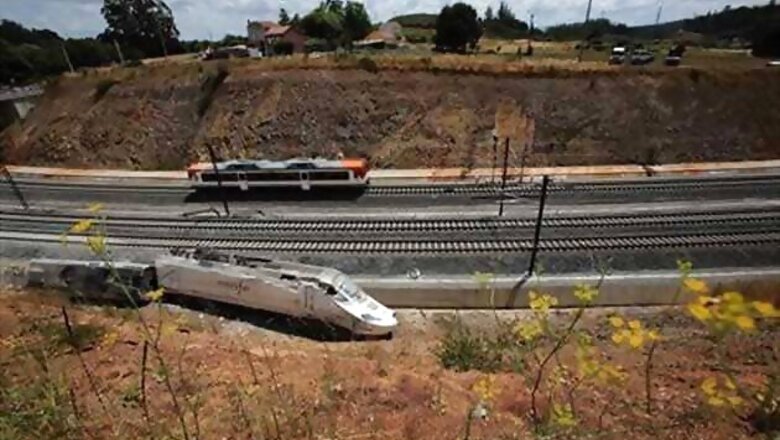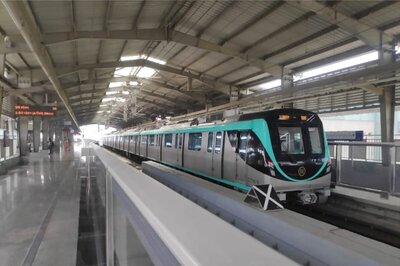
views
Spanish police were investigating on Friday if the driver of a train that crashed in Santiago de Compostela killing dozens had been driving at reckless speed when he took a tight curve.
Spain's worst train accident in decades on Wednesday evening killed at least 78, with three bodies still unidentified and 81 people in hospital, raising questions about the experienced railwayman's actions.
The driver, Francisco Garzon, 52, was under arrest at a hospital in Santiago, the capital of the northwestern region of Galicia. He had been due to give a statement to police but local media reported he had declined to do so.
Garzon was being investigated for criminal behaviour in causing the accident and "recklessness", regional police chief Jaime Iglesias said.
A spokeswoman for Galicia's Supreme Court said Garzon had not yet been charged and evidence including from the train's "black box" data recorded was being assembled.
"We're collecting elements to be used as evidence, videos, audios and all the technical work that is being done on the train," she said.
Renfe, the Spanish state train company, said Garzon was a 30-year company veteran who had been driving for a decade. He was highly qualified and had been driving on the line where the accident took place for about a year. The train was running on time when the crash occurred.
On the morning of the tragedy, he had driven a train on the same line, which connects the coastal city of La Coruna with Madrid, and a Renfe spokesman said he knew every twist and turn of the route.
Spanish media have widely reported that Garzon took the sharp curve with an 80 km/h (50 mph) speed limit at more than twice that speed. The driver was not available for comment and Reuters was not able to locate his family or his lawyer.
The head of the state track operator ADIF said on TV news that there was a sign warning drivers to slow 4 km before the curve, which follows a section of high speed track.
However, another train driver on the line told Cadena Ser radio that the blame should not be put on his colleague.
"There is no safety warning for the speed, it's pure human factor, you have to slow down manually and you have no assistance in the cabin," said Manuel Mato. "When you exit the high-speed section you start slowing down ... you have like 4 km to the curve," he added. A high-speed train would cover that distance in less than a minute.
Investigators from the Public Works Ministry, Renfe and ADIF were expected to look into everything from potential brake failure to the safety system meant to force the train or driver to slow down.
Security video footage showed the train, with 247 people on board, hurtling into a concrete wall at the side of the track as carriages jack-knifed and the engine overturned.
The impact was so strong that one carriage flew over a wall and landed on an embankment several metres above.
"We could feel the carriage lift off from the rails, it was all so quick, it was like (being inside)... a washing machine, turning around very quickly. Suddenly everything was upside down and the carriage was full of seats and open suitcases," Esther Dominguez, a 23-year-old student from Madrid who survived the crash, told Reuters.
Spain's Crown Prince Felipe and his wife Princess Letizia visited the injured in hospital on Friday as well as volunteers who helped in the aftermath of the tragedy.
The crash happened on the eve of the festival of St James, one of Jesus's 12 disciples, whose remains are said to rest in a Santiago shrine that draws huge numbers of pilgrims every year. Thousands of people were in town for the annual event, which was cancelled when officials declared a week of mourning.
Four foreigners were among the dead, from the United States, Italy, Mexico and Algeria.
The train involved, made by Bombardier and Talgo, was a series 730 that Renfe uses for its Alvia service, which is faster than conventional trains but slower than AVE trains that criss-cross Spain at even higher speeds.
The train was built in 2007-2009, but remodelled in 2012.
The train is designed to operate on conventional and high-speed tracks that make use of two different types of safety systems that are meant to regulate excessive speed.
On high-speed lines, trains use the European Train Control System, or ETCS, which automatically slows down a train that is going too fast.
On slower lines, trains operate under an older system called ASFA, a Spanish acronym for Signal Announcement and Automatic Braking, which warns the driver if a train is moving too fast but does not automatically slow it down.
At the site of the disaster, just 3 km (2 miles) before reaching the Santiago de Compostela station, the train was passing through an urban area. At that point of the track, two railway experts said, it uses the older ASFA safety system.
Professor Roger Kemp, a fellow of the Royal Academy of Engineering in Britain, said in an e-mailed comment that as the driver was leaving the high-speed line to join a much slower route before entering the station, there must have been at least prominent visual warnings to reduce speed, if not audible warnings and an electronic speed supervision system.
A source close to ADIF said the safety system was apparently working correctly and a train had passed an hour earlier with no problems.

















Comments
0 comment